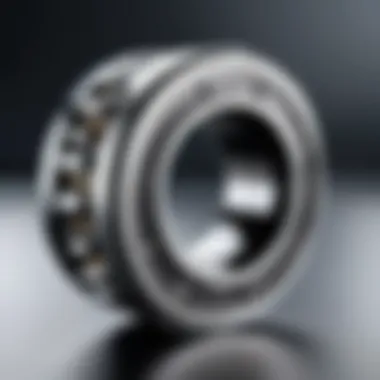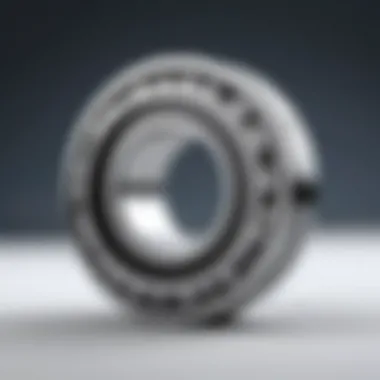Understanding the Koyo 6203 RS Bearing: Key Insights


Intro
The exploration of mechanical components has never been more essential, especially when considering their impact on machinery performance. The Koyo 6203 RS bearing offers significant insights into how engineering precision works. This article delves into its specifications, applications, and critical insights relevant for those who work with mechanical systems.
Understanding the nuances of such components can lead to enhancements in efficiency, reliability, and overall performance in a variety of settings. Now let’s begin with an overview of the Koyo 6203 RS bearing.
Product Overview
Brief Description
The Koyo 6203 RS bearing is a deep groove ball bearing designed to accommodate both radial and axial loads. It features a rubber seal on one side, which protects the internal components from contaminants, ensuring durability and longevity. This bearing is particularly suited for applications where maintenance access is limited, making it a preferred choice in various industrial settings.
Key Features
- Sealed Design: The rubber seal on the Koyo 6203 RS reduces the risk of dirt and moisture entering the bearing, thus extending its operational life.
- Versatile Fit: Its design allows for flexibility in a wide range of applications, including automotive and machinery sectors.
- High Load Capacity: This bearing can endure heavy loads, enhancing performance in demanding situations.
Available Variants
The Koyo 6203 RS bearing comes in several variants, including different sealing types and dimensions tailored for specific applications. Users can choose options like Koyo 6203 ZZ, which features metal shields for applications requiring higher speed and lower drag friction.
Specifications Breakdown
Technical Specifications
- Inner Diameter: 17 mm
- Outer Diameter: 40 mm
- Width: 12 mm
- Material: High-quality Chrome Steel
Performance Metrics
The Koyo 6203 RS bearing typically operates effectively at temperatures ranging from -30°C to +120°C, allowing it to function in diverse environments without compromising performance.
Compatibility Information
It is important to ensure that the Koyo 6203 RS is compatible with shafts and housing used in specific machines. The bearing's tolerances and size make it adaptable to many industrial and commercial applications, providing versatility for users looking to replace bearings in existing setups.
Comparative Analysis
Competing Products
Several alternatives exist in the market, including the SKF 6203, NTN 6203, and FAG 6203. Each competitor has unique advantages in terms of performance and pricing.
Strengths and Weaknesses
Strengths:
- Durability: Excellent longevity due to sealed design.
- Load Capacity: Handles high loads with ease.
Weaknesses:
- Cost: Some variants may come at a higher price compared to non-branded options.
Price Comparison
While prices can fluctuate, typically, the Koyo 6203 RS ranges from $5 to $15, depending on the supplier and specific features selected.
Buying Guide
Target User Profiles
This bearing is ideal for a range of users including:
- Mechanics seeking reliable components for repairs.
- DIY enthusiasts upgrading their tools.
- Engineers designing systems requiring robust solutions.
Important Considerations
Before purchasing, consider:
- Load Requirements: Ensure the bearing can handle the load needed.
- Environmental Conditions: Select a sealing type based on exposure to dust or moisture.


Insider Tips for Buyers
- Compare prices from multiple suppliers for the most competitive rate.
- Check user reviews online for feedback on specific applications.
Maintenance and Upgrade Insights
Regular Maintenance Practices
- Lubrication: Even sealed bearings require periodic checks to ensure lubrication is effective.
- Inspection: Regular visual inspections can reveal early signs of wear.
Upgrade Paths and Options
If seeking improved performance, consider higher-grade materials or bearings designed for higher RPMs.
Troubleshooting Common Issues
Typical issues include noise or overheating, which can indicate lack of lubrication or misalignment. Address these problems promptly to maintain operational efficiency.
Understanding the Koyo 6203 RS bearing not only facilitates informed decision-making but also enhances overall machinery effectiveness.
This comprehensive look at the Koyo 6203 RS bearing provides necessary insights for professionals engaged in mechanical work, enabling a deeper understanding of its role in various applications.
Preamble to Koyo Bearings
The significance of Koyo bearings extends far beyond mere components in machinery. They play a vital role in ensuring efficient movement and load distribution across various mechanical systems. This article seeks to explore the implications of using Koyo bearings, particularly the Koyo 6203 RS model, which is widely recognized for its reliability and adaptability in diverse environments.
Understanding Koyo bearings can facilitate better decision-making in selecting the right component for different applications. Key aspects include the history, reputation, specifications, and applications of these components. Furthermore, awareness of their unique features can enhance overall mechanical efficiency and longevity.
History and Reputation
Koyo Bearings, a brand of JTEKT Corporation, has a rich history dating back to 1921. This foundation has enabled the company to establish a strong reputation in the bearing industry. The commitment to quality and innovation has driven Koyo to produce bearings that meet the stringent demands of various sectors, including automotive, industrial, and electrical applications.
Throughout the decades, Koyo has focused on research and development to improve performance, durability, and efficiency. These efforts have led to a reputation for producing high-quality bearings that can withstand harsh conditions and operate under heavy loads. Koyo has built trust among engineers and mechanics who rely on these components for their machines. This trust is reinforced by extensive testing and adherence to international standards, making Koyo a preferred choice for professionals globally.
“Koyo has become synonymous with reliability in the bearing industry, continuously adapting to meet the evolving needs of technology.”
In sum, Koyo Bearings have a storied legacy marked by innovation and a commitment to excellence. Understanding this context enhances appreciation for their products, like the Koyo 6203 RS, and underscores the importance of informed choices in mechanical design.
Technical Specifications of Koyo RS
Understanding the technical specifications of the Koyo 6203 RS bearing is essential for anyone looking to use this component effectively in various applications. These specifications provide insight into the bearing's operational capabilities, durability, and suitability for specific tasks. By dissecting the various aspects of the Koyo 6203 RS, we can come to appreciate its design and how it supports performance in mechanical systems.
Dimensions and Ratings
The dimensions of Koyo 6203 RS are critical in determining how it fits within any bearing application. The bearing has a 17 mm inner diameter, a 40 mm outer diameter, and a 12 mm width. These measurements play a significant role in how the bearing interacts with other components and the load it can effectively handle.
The ratings for the Koyo 6203 RS include various speed and load considerations. This bearing typically operates at relatively high rotational speeds while maintaining efficient load distribution. Knowing the correct dimensions and ratings can prevent potential performance issues, ensuring the bearing operates within its optimal range.
Material Composition
Material composition is vital for the longevity and functionality of the Koyo 6203 RS bearing. This bearing is primarily constructed from high-carbon chromium steel, known for its excellent hardness and wear resistance. Its inner and outer races, as well as the rolling elements, are all made from this reliable material, allowing for reduced friction during operation.
The steel's ability to withstand thermal expansion helps maintain dimensional stability, crucial for precision applications. Additionally, Koyo often incorporates high-quality sealing materials, enhancing the bearing's resistance to contamination and extending its useful life. The choice of materials directly influences both performance and maintenance frequency.
Load Ratings and Speed Limits
Understanding the load ratings and speed limits associated with the Koyo 6203 RS is crucial for any engineering professional or DIY builder looking to integrate the bearing into their design. The dynamic load rating for this bearing is approximately 10,300 Newtons, which reflects its capacity to sustain loads while rotating.
The static load rating is around 5,400 Newtons, representing the maximum load the bearing can withstand without rotation. Regarding speed, the Koyo 6203 RS has a maximum operating speed of about 30,000 RPM, making it suitable for various high-speed applications.
Keeping these load ratings and speed limits in mind will assist users in selecting the right bearing for their needs, ensuring compatibility with existing systems and prolonging the bearing's operational life.
In summary, the technical specifications of the Koyo 6203 RS define its capabilities and performance, establishing a foundation for its application in different fields.
Construction Details of Koyo RS
The construction details of the Koyo 6203 RS bearing are essential for understanding its function and reliability in various applications. The design and materials utilized in the bearing's construction significantly impact its performance, durability, and maintenance requirements. This section will explore the sealing features that enhance the bearing's effectiveness and resilience in demanding environments.


Sealing Features
Koyo 6203 RS bearings are equipped with specific sealing features that are critical to their performance. These seals serve to protect the internal components of the bearing from contaminants, such as dust and moisture, which can lead to premature wear or failure. The type of sealing used in the Koyo 6203 RS is known as rubber seal, which provides a tight fit around the bearing’s outer race.
The rubber seal offers several benefits:
- Protection against contamination: The primary function of the rubber seal is to keep dirt and debris from entering the bearing's internal structure. This is especially important in environments where exposure to particulate matter is high.
- Retention of lubricant: The seal helps in retaining lubricant within the bearing. Proper lubrication is essential for reducing friction and preventing overheating, so seals that retain this lubricant are vital for extending the life of the bearing.
- Durable materials: The rubber used for these seals is designed to withstand various temperatures and mechanical stresses. This durability ensures that the seal maintains its integrity over time, providing ongoing protection and performance.
- Balancing friction: While the primary function of the seal is protection, it also plays a role in managing friction. A well-designed seal minimizes resistance caused by contact with the bearing races, allowing for smooth operation while keeping contaminants out.
In addition to these benefits, it is essential to consider the importance of appropriate installation of these seals. Misaligned or improperly fitted seals can compromise their effectiveness, leading to potential issues down the line. Therefore, understanding the installation process is crucial for anyone working with Koyo 6203 RS bearings.
Key Point: The sealing features of the Koyo 6203 RS are fundamental for maintaining the bearing's functionality, reducing maintenance needs, and prolonging its lifespan.
Applications of Koyo RS Bearing
The Koyo 6203 RS bearing plays a vital role in various industries, making it essential to understand its applications. The significance of this topic in the broader context of mechanical systems cannot be overstated. The bearing's capacity to support loads, provide stability, and reduce friction is critical for performance across different applications. Understanding these aspects ensures that individuals in engineering and technical fields can make informed decisions regarding its use.
Use in Automotive Applications
In the automotive sector, the Koyo 6203 RS bearing is a fundamental component. It is commonly found in wheel hubs, electric motors, and various drivetrain applications. Its ability to withstand axial and radial loads makes it suitable for high-speed environments, which are typical in modern vehicles.
The presence of rubber seals in the Koyo 6203 RS provides protection against dust and moisture, enhancing its longevity. Its dimensions and load ratings align with automotive design requirements, ensuring a perfect fit. This bearing can often operate efficiently under varying temperatures, contributing positively to overall vehicle performance.
Role in Industrial Machinery
Industrial machinery depends heavily on reliable components. The Koyo 6203 RS bearing is frequently used in conveyor systems, pumps, and compressors. These machines require precise movement and reliable handling of loads, areas where the Koyo bearing excels.
The efficiency of this bearing reduces operational downtime, a crucial factor in industrial productivity. Further, its adaptability in various configurations allows for integration into different types of machinery without significant modifications.
Applications in Electrical Motors
Electrical motors often utilize the Koyo 6203 RS bearing to enhance performance and reliability. In this application, the bearing minimizes friction between moving parts, helping to maintain efficiency and reduce energy consumption. This characteristic is particularly important in both AC and DC motors, where power loss can be detrimental.
With its compact size and robust design, the Koyo 6203 RS bearing enables manufacturers to create motors that are both powerful and space-efficient. Its compatibility with multiple motor types makes it a preferred choice in the design of various electrical devices, from household appliances to industrial equipment.
The applications of Koyo 6203 RS bearing demonstrate its versatility and crucial role in enhancing the performance of mechanical systems across industries.
Performance Characteristics
Understanding the performance characteristics of the Koyo 6203 RS bearing is crucial for its effective application across various mechanical systems. Performance directly impacts the bearing's efficiency, longevity, and overall reliability. By delving into these characteristics, users can optimize their applications for enhanced performance, reduced friction, and improved energy consumption.
Bearing Efficiency and Friction
The efficiency of the Koyo 6203 RS bearing is defined by its ability to minimize friction during operation. This efficiency is significant for several reasons:
- Energy Savings: Reducing friction translates to lower energy consumption. In applications where multiple bearings are used, even a small reduction in friction can lead to substantial energy savings over time.
- Heat Generation: Increased friction results in heat buildup, which can compromise the integrity of the bearing and associated components. Efficient bearings help maintain lower operating temperatures.
- Extended Lifespan: Bearings that operate efficiently experience less wear. This leads to a longer service life, reducing the frequency and cost of replacements.
To achieve optimal performance, several considerations must be made:
- Lubrication: The type and amount of lubrication play a pivotal role in the efficiency of the bearing. Proper lubrication minimizes direct contact between surfaces, thereby reducing friction.
- Alignment: Ensuring correct alignment during installation is essential. Misalignment can lead to uneven load distribution, which increases friction and wear.
- Load Management: Understanding the load characteristics in your specific application is important. Exceeding recommended load limits can drastically reduce efficiency and increase failure risks.
Proper management of these factors can lead to significant improvements in the overall functionality of mechanical systems employing the Koyo 6203 RS bearing. Regular inspection and adjustments, when necessary, are vital to maintaining performance.
Maintenance and Care for Koyo RS
Maintenance and care for the Koyo 6203 RS bearing is crucial to extend its lifespan and ensure optimal performance. Proper upkeep not only minimizes the risk of failure but also enhances the efficiency of the machinery it supports. Key components of maintenance include correct installation, effective lubrication, and regular inspection of the bearings.
Proper Installation Techniques
The installation process for the Koyo 6203 RS bearing is fundamental to its operational efficiency. A misaligned or improperly fitted bearing can lead to premature wear and failure. The following steps can improve installation accuracy:
- Ensure Cleanliness: Remove any dirt or contaminants from the bearing and housing before installation. Dirt can cause abrasive wear.
- Use Correct Tools: Employ appropriate tools for the installation. A bearing installer and a hammer designed specifically for this task can prevent damage.
- Follow Manufacturer Guidelines: Adhere to the technical specifications provided by Koyo. This includes using the right press fit and checking alignment.
- Measure End Play: After installation, measuring the end play is essential. This measurement confirms that the bearing is correctly seated within the housing.
Implementing these techniques can greatly affect the overall performance of the Koyo 6203 RS in any application.
Lubrication Guidelines
Lubrication plays a significant role in the longevity of the Koyo 6203 RS bearing. It reduces friction and wear while preventing overheating. Follow these guidelines for effective lubrication:


- Choose Suitable Lubricants: The selection of the right grease or oil is essential. Refer to Koyo’s specifications for recommendations.
- Frequency of Application: Establish a regular schedule for lubrication. Too infrequent can lead to wear, while over-lubrication can cause overheating.
- Application Method: For grease, use a grease gun to apply the lubricant evenly. For oil, it should be easily accessible for periodic changes.
- Monitor Lubricant Condition: Regularly inspect the condition of the lubricant. Discoloration or contamination indicates that replacement is necessary.
Proper lubrication ensures that the bearing operates smoothly, effectively reducing friction and heat.
Inspection and Replacement Indicators
Regular inspection of the Koyo 6203 RS is essential to catch potential issues early. Here are some signs that maintenance may be required:
- Unusual Noises: Grinding or squeaking sounds can indicate insufficient lubrication or worn-out elements.
- Vibration: Increased vibration may suggest misalignment or wear, leading to operational inefficiencies.
- Heat Generation: Higher than normal temperatures can be an indicator of both overloading or lubrication problems.
- Visual Examination: Inspect for signs of rust, pitting, or other forms of wear. Physical damage often signals the need for replacement.
By being attentive to these indicators, maintenance can be proactive rather than reactive.
The longevity of the Koyo 6203 RS bearing is directly tied to how well it is maintained. Regular care practices can significantly reduce replacement costs in the long run.
Comparison with Other Bearings
Comparing the Koyo 6203 RS bearing to other bearings in the market provides vital insights that can guide professionals in making informed choices. The performance, durability, and suitability of bearings in specific applications differ widely. By understanding these differences, users can better align their selection with their operational requirements.
Differentiating from Similar Models
When it comes to comparing bearings, it is crucial to analyze how the Koyo 6203 RS stands out from its contemporaries, such as the SKF 6203 and the NSK 6203. Each of these models has its distinct features and applications. Here are some key points of differentiation:
- Sealing Configuration: The Koyo 6203 RS features a rubber seal, ensuring effective protection against contamination. This design can outperform other models which may use metal shields that allow for certain entry of dirt and moisture.
- Load Capacity: The load ratings of the Koyo 6203 RS may be relatively higher in comparison to similar bearings, particularly under dynamic loading conditions. This characteristic enhances its reliability in high-stress applications.
- Operating Temperature: The Koyo 6203 RS can maintain optimal performance over a broader temperature range, making it suitable for diverse environments where other bearings may falter.
- Material Quality: Koyo’s commitment to material quality often gives its bearings longer service lives, especially under harsh conditions. While many manufacturers utilize standard steel, Koyo may incorporate higher-grade alloys that enhance durability.
When choosing a bearing, consider not only the specifications but also the application environment.
By thoroughly assessing the nuances between the Koyo 6203 RS and similar bearings, engineers and designers can make better decisions that lead to optimal performance in their mechanical systems.
Challenges and Limitations
Understanding the challenges and limitations of the Koyo 6203 RS bearing is essential for anyone utilizing this component in their mechanical systems. It allows users to make informed decisions about its applications and ensures that potential issues are addressed before they escalate. Recognizing these elements can lead to increased longevity and reliability of machinery, thus enhancing overall efficiency.
Failure Modes and Prevention
When it comes to bearings like the Koyo 6203 RS, several failure modes can arise due to various factors. These modes include, but are not limited to, premature wear, improper lubrication, and contamination. Each of these factors can lead to significant performance degradation.
- Premature Wear: This can occur due to excessive load or inadequate maintenance. It is important to monitor the bearing's operational conditions closely to fend off this problem.
- Improper Lubrication: Correct lubrication is crucial. Inadequate lubrication can cause overheating and increased friction. Employing the right lubrication methods and materials is necessary to optimize performance.
- Contamination: Dust, dirt, or moisture entering the bearing can severely damage it. Using protective seals, like the ones in the Koyo 6203 RS, helps prevent this from happening.
Effectively preventing these failures involves regular inspections and adherence to maintenance schedules. An inspection can reveal signs of wear, and acting on these signs early may extend the bearing's lifespan significantly. Regarding lubrication, it is advisable to follow manufacturer guidelines. Each bearing has its specific requirements, and adhering to these can drastically reduce the chance of failure.
Regular maintenance can increase the efficiency and lifespan of your Koyo 6203 RS bearings.
Understanding these modes and taking preventative measures ensures the Koyo 6203 RS bearing operates at its best, providing reliability in automotive, industrial, and electrical applications. This awareness is an integral part of responsible use and management of bearings in any machinery.
Market Overview
The market overview of the Koyo 6203 RS bearing is significant as it reflects the current trends and demands within the bearing industry. Understanding market dynamics helps professionals in identifying opportunities, adjusting strategies, and ensuring product compatibility. This section explores key elements that highlight the relevance of the Koyo 6203 RS bearing in various applications.
Factors such as global economic trends, shifts in industrial needs, and advancements in technology influence the bearing market. As industries become more competitive, the demand for high-quality components grows. Koyo, being a reputable brand, aligns its production with these trends, ensuring that users can rely on its bearings for robust performance.
Current Trends in Bearing Technology
In recent years, bearing technology has witnessed significant advancements. These trends help improve performance, durability, and reliability in various applications.
- Material Innovations: New materials enhance the strength and wear resistance of bearings. Advanced composites and high-performance metals are increasingly used to prolong lifespan and reduce maintenance needs.
- Enhanced Sealing Solutions: Innovations in seal design protect against contaminants and retain lubrication. For the Koyo 6203 RS, effective sealing is crucial to maintain performance in demanding conditions.
- Sustainability Practices: Manufacturers are focusing on eco-friendly processes. This includes reducing waste and using recyclable materials to fulfill environmental regulations without compromising performance.
- Smart Technology Integration: The incorporation of sensors into bearings facilitates real-time monitoring of performance metrics. This trend allows for predictive maintenance and minimizes downtime.
Understanding these trends provides valuable insights for those involved in design, maintenance, or application of bearings. The Koyo 6203 RS, with its solid specifications and application potential, remains a strong player amid these technological advancements.
The Koyo 6203 RS is a benchmark in reliability and efficiency, adapting well to modern challenges in engineering and manufacturing industries.
End
The conclusion of this article serves as a crucial summary of the main points discussed regarding the Koyo 6203 RS bearing. Understanding its specifications, applications, and maintenance is essential for professionals and enthusiasts alike. Knowledge of the bearing's features, such as its dimensions and sealing mechanisms, is invaluable in selecting the right component for various mechanical systems.
In essence, the Koyo 6203 RS bearing represents a balance of efficiency and reliability. Its design accommodates multiple uses in automotive, industrial, and electrical applications, showcasing its versatility. Thus, being knowledgeable about its performance characteristics and how to maintain them effectively can lead to optimized performance and extended lifespan of machinery.
Additionally, awareness of current trends in bearing technology can inform future purchases and installations. Seeking insight into market offerings and comparisons with similar models can further assist in making educated choices.
"The right bearing choice can dramatically affect the overall performance of your machinery."
Overall, this understanding contributes significantly not only to enhanced mechanical reliability but also to cost-effectiveness in operations. Recognizing the implications of installation and care springs from knowing the intricacies of the Koyo 6203 RS makes a substantial difference. Ultimately, this knowledge fosters informed decision-making, positioning users for success in their projects and applications.
Summary of Key Takeaways
- The Koyo 6203 RS bearing features specific dimensions and material composition crucial for its function.
- It applies to a diverse range of sectors, including automotive, industrial machinery, and electrical applications.
- Proper installation and maintenance practices are pivotal for maximizing the bearing's performance.
- Understanding market and technology trends aids in better decision-making concerning bearing usage.
- Insights into failure modes and preventive measures can extend the lifespan and reliability of machinery.



